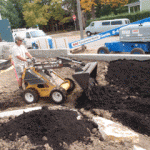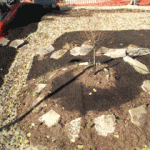Teeming with life-giving organisms that transform inorganic minerals in the ground into food for flora, soil is a vibrant and diverse ecosystem. It is a fundamental building block of life.
When embarking on any building or renovation project, managing soils and the handling of erosion control may be one of the first thoughts to occur. This consideration is crucial, really, to the healthy development of sustainable neighborhoods and to the networks of interconnected systems. Throughout much of the early 1900’s, farming practices sometimes did not think to address erosion specifically and consequentially farmlands lost half an inch per decade of topsoil each year. Not only is this loss of topsoil detrimental to the productivity of our farmlands but the material that runs off the land clogs waterways and disrupts aquatic life.
The LEED and Sustainable SITES programs provide extra focus on erosion control and other soil management methods. This focus makes soil conservation one of the first points of concern, so that when any ground vegetation is disturbed, appropriate restoration methods are designed and implemented as part of the original planning.
At Green & Main, we would like to preserve the ground cover to prevent the exposure of new soil as much as possible, as relevant plant life is the best erosion and stormwater control method. Typically, when a construction project is underway, silt fencing and cloth/straw socks are used to prevent water from carrying away soils. On site, we also focus on vehicle entry ways, using gravel and similar materials to prevent soils from being carried into the streets by vehicle tires.
When planning for superior erosion control, it is important to look beyond initial construction. Natural barriers such as swales and rain gardens help inhibit erosion and promote deep groundwater infiltration. Careful selection of plants also helps hold soils and slow the movement of water through the site. The soil composition itself can assist with water retention and water control. In fact, adding compost to the soil helps absorb the water and an addition of two inches of compost can hold up to five inches of water.
Taking the lead, Green & Main has incorporated many methods of soil and water management to contain water onsite, particularly by means of creative water pathways, bio-swales and rain gardens. This project has rebuilt and revitalized the original soil and transformed a typical urban grass yard that has seen much change through the years into a native plant habitat. Going well beyond the standard measures of erosion and water control, Green & Main has rebuilt a local soil ecosystem using this organic approach to green building and soil management.
– James McCain is a renewable energy expert and a future organic farmer. He played a recent role in the establishment of the Tallgrass Grocery Co-Op in West Des Moines.











It is definitely important to be aware of erosion if it is taking away that much of your topsoil. Could you explain how water pathways work? I would like to know if this method would work for my situation. Thank you for your detailed information on how erosion can be detrimental to good land and how to deal with it!